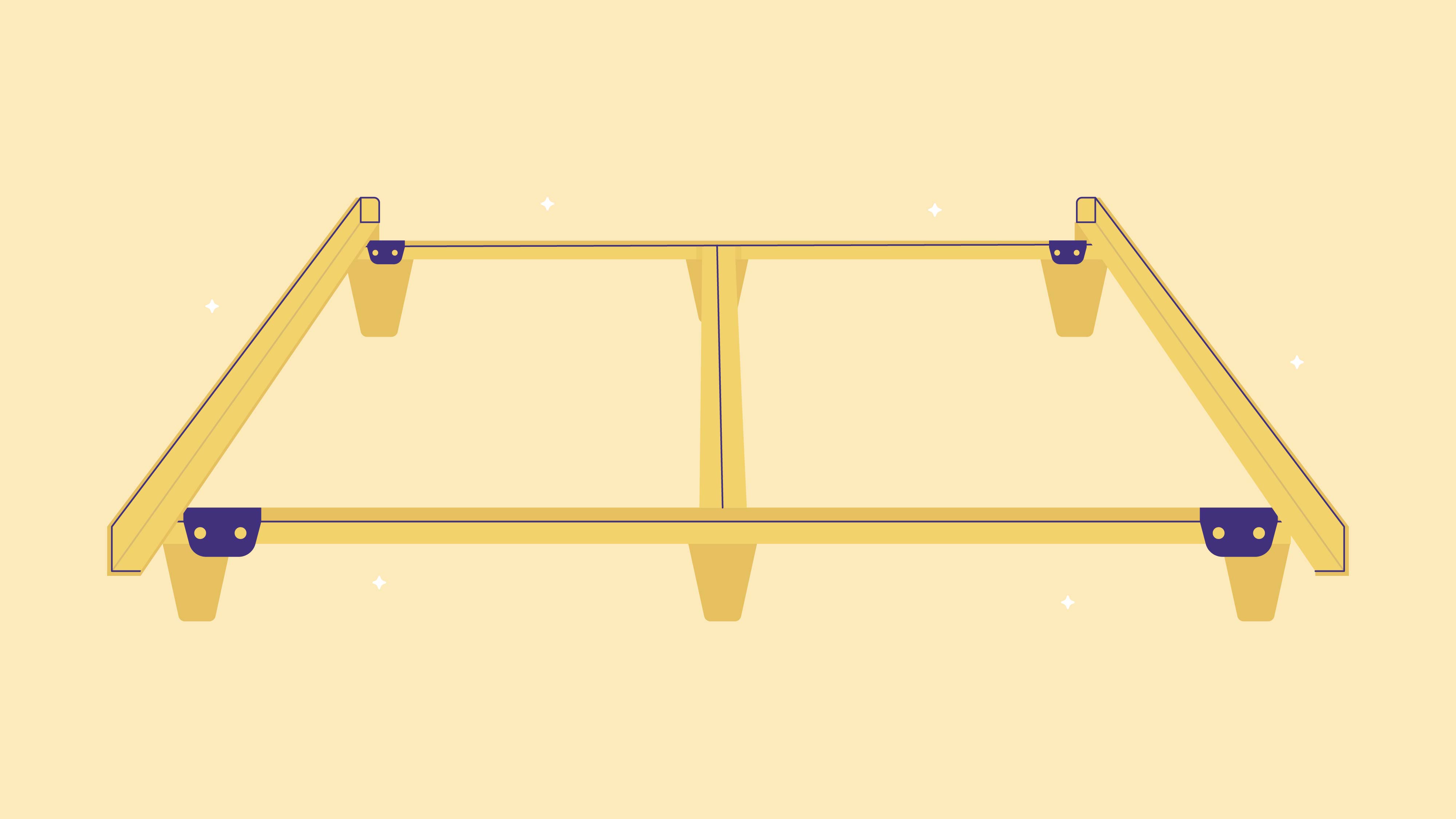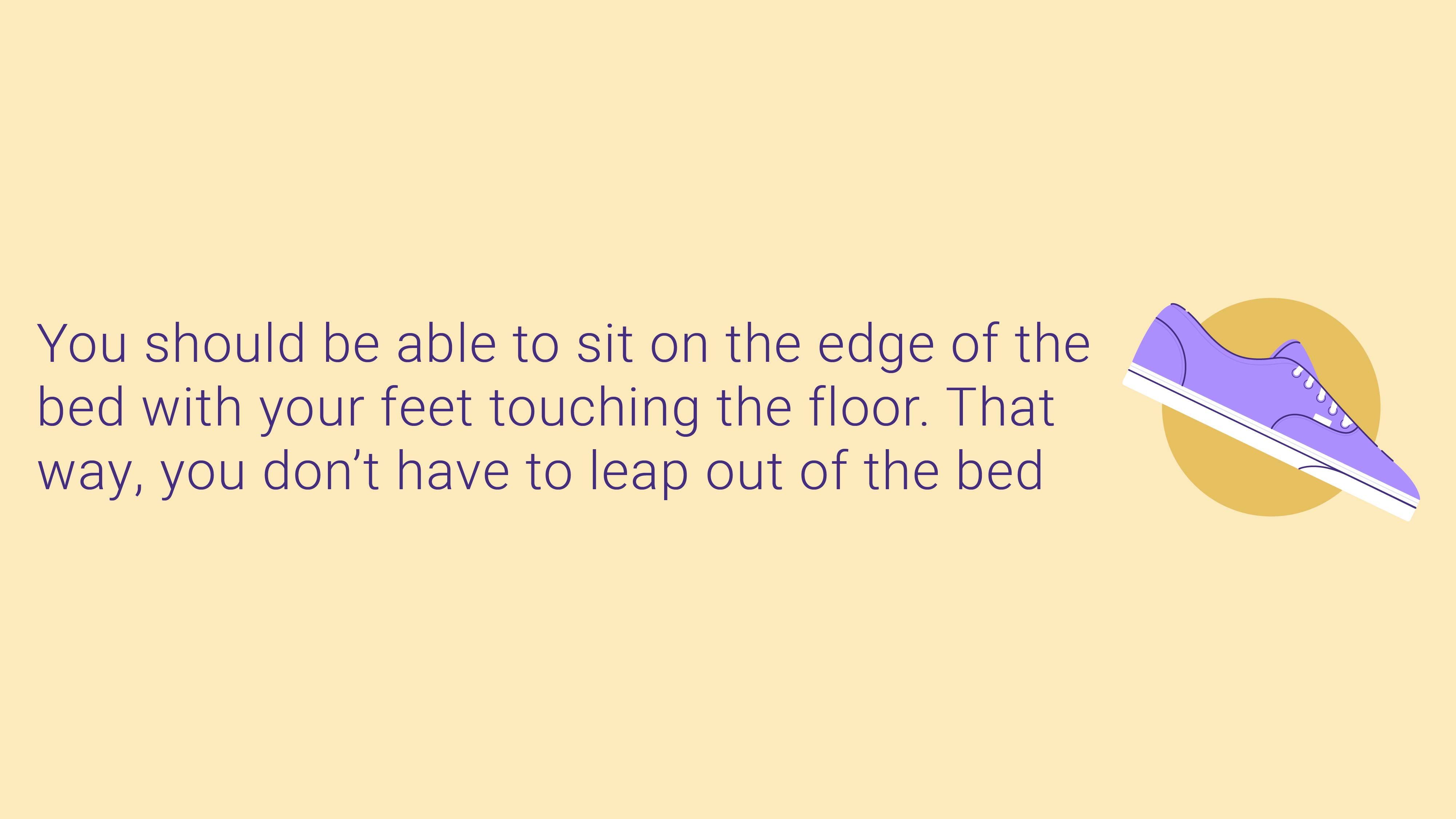
Bed Frame Sizes and Dimensions Guide

- Consider the dimensions: Twin, Twin XL, Full, Queen, King, or California King, and how they fit into your room and lifestyle.
- Evaluate the pros and cons of each size, including portability, price, and sleeping space.
- Take into account the bed frame height and other mattress foundations to find the most comfortable option for you.
Buying a bed can be exhausting. There’s just so much to think about, and every time it feels like you’ve got it all figured out, something else seems to pop up. The size of your bed frame is one of the most important aspects of your bed-buying venture. But sometimes in all the fuss over mattress material, firmness, and thickness, frame size can get put on the back burner.
However, if you get the wrong frame size for your lifestyle, it could turn into a huge headache. There are tons of things to think about, like portability, the size of your room, your height, your budget, and the number of sleepers using the bed. Below, we break down the different bed sizes and discuss their advantages and disadvantages to help you decide the right size for you.
Twin
The humble twin mattress is the smallest of the lot. At only 39 by 75 inches, this mattress size definitely won’t give you a whole lot of wiggle room. However, if you have multi-kid bedrooms, bunk beds, or you just want to make the most of the space in a tiny apartment, this bed is still a perfectly comfortable option for most people. Just be sure to buy a sturdy frame and a high-quality mattress.
Portability
Of all the standard mattress sizes, the twin is the most portable. It can easily be carried up and down stairs, around corners, and from apartment to apartment. If you move a lot, a twin can easily go where you do.
Price
Twins are also usually the cheapest option out there. If you’re furnishing your first apartment or trying to cut the costs of getting your kids a new bed, this one might be for you.
Size
Twins are a perfect fit for tiny rooms. They’re both the shortest and narrowest option, so if you’re in a studio or you just have a tiny guest room, the twin may be the best choice.
On the flip side, since the twin bed is so narrow, it won’t give you a lot of wiggle room while you’re sleeping. At only 75 inches long, twins also may not be the most comfortable choice for taller sleepers.
Room Dimensions
The size of a twin generally dictates that it should go in a small room. A room that’s 7 by 10 or 10 by 10 square feet is usually a good fit. The bed will fill out the room without taking up so much space that you can’t add a few other pieces of furniture like a dresser or nightstand. It will also leave plenty of walking space in a smaller room.
Twin XL
The second-smallest adult-sized bed, this 39 by 80-inch frame is a staple of college dorm rooms. It also works well in multi-bed guestrooms. The twin XL mattress doesn’t offer the most sleeping space, but it does offer convenience, portability, and an extra five inches of legroom for people whose feet might be hanging off of a 75-inch frame.
Portability
Twin XL beds are a little longer, so they’re not going to be quite as easy to pivot around stairwell corners or throw in any old truck bed. If you’re tall, though, the extra space may be worth the effort of moving those extra five inches of length.
Price
The twin XL is usually a little more expensive than a standard twin, but it’s still well within most people’s price range.
Size
At five inches longer than a standard twin or a full bed, the XL might be the best size for you if you’re a tall single sleeper who has to fit a bed into a small space. However, since the XL frame is just as narrow as the standard twin, the wiggle room while you sleep is still going to be an issue.
Room Dimensions
Generally, the twin XL works in the same room size as a standard twin. It is equally narrow and only five inches long, so its impacts on furniture and walking space won’t be much different in rooms with limited space.
Full
The full is the standard “single adult” bed size. If you’ve got a smaller bedroom, 54 by 75 inches will offer you a comfortable amount of sleeping space along with more convenient and easy-to-move dimensions.
Portability
The full size mattress doesn’t offer quite the portability of a twin, but the wiggle room the extra width offers is usually worth the trade-off. Getting it up and down multiple flights of apartment building stairs might come with some challenges, but if you live in a house, you usually don’t have to worry about moving this one in and out.
Price
While pricier than either kind of twin, full beds are still more budget-friendly than queens or kings. Again, the extra wiggle room is worth the added expense to a lot of people.
Size
The full bed offers lots of sleeping space for one person. However, it is really too small to accommodate two sleepers. With only 27 inches of width per person, two average-sized adults will each have the same sleeping area as they would if they slept in an elongated child’s crib (also 27 inches wide). Also, if you’re on the taller side, you may need to go up to the longer queen to have enough legroom.
Room Dimensions
If you’re not planning on using a whole lot of other furniture in your bedroom, a full will also do well in a small space, like a 10 by 10 or 10 by 12-foot room. Just remember that the extra width may limit the amount of other furniture you can place in a smaller room.
Queen
The queen size mattress is the most popular frame size in the US because it works for single sleepers and couples alike without taking up the whole room. At 60 by 80 inches, the queen’s bed frame dimensions offer plenty of space for one adult and just enough for two. The queen is usually considered the smallest size suitable for couples.
Portability
Combination sleepers who move a lot may want to opt for a queen. It will offer sufficient room for two people whilst simultaneously offering roughly the same portability as a full sized bed. It might be a little harder to shimmy around a stairwell or through a small doorway, but it’s still easier to deal with than a king.
Price
The queen is a good mattress for couples shopping on a budget. The frame is a lot less expensive than a king, and the queen is the largest bed that takes standard-sized pillows. Once you start buying king sized accessories like comforters, sheets, and pillows, the price of your whole bed can go way up, so a queen is a good option if you want a larger bed but don’t want the added expense of king accessories.
Size
Queen beds are big enough for co-sleepers—but only just. If you move around a lot at night or like to spread out, you may disturb your partner on a queen bed. Yet, if you’re both pretty calm sleepers and neither of you needs a ton of space to be comfortable, you can easily get away with a queen.
Room Dimensions
If you’re planning on putting a bunch of end tables, chairs, benches, dressers, and vanities in your bedroom, you’ll probably need a 10 by 14 or even a 12 by 14-foot room to hold it all. However, if you’re only planning to sparsely furnish your bedroom, a queen could be best even for a room as small as 10 by 10 feet—the bed will make up for the lack of other furnishings, making the room appear fuller.
King
The standard or eastern king bed is the widest of all the standard sizes at 76 by 80 inches. If you want something even wider, you’ll have to have a custom bed made or find a store that sells oversized mattresses like Alaska or Texas king beds. The king is usually sought after by couples because it offers the same dimensions as two twin XL beds, thus allowing sufficient space for comfort.
Portability
The king is not very portable. King mattresses are so heavy they often require multiple people to lift them, and the king size bed frame is usually tough to disassemble and reassemble. The 76 inches of width can also pose problems in stairs or doorways. The average doorway is only 80 inches tall, giving you a measly 4 inches of space to get the mattress through.
Price
The standard king is expensive. The mattress and frame are pricey on their own, and the added expense of the accessories can take a toll on the budget.
Size
If you want a ton of room for yourself, your partner, and your kids, the king bed might be for you. It’s wide enough to accommodate two adults and one or two small children and still long enough for most people’s heights.
Room Dimensions
Kings take up a lot of the space in your room that would otherwise be used for walking or furniture. This means you really shouldn’t put a king in anything smaller than a sparsely furnished 12 by 12-foot room or a fully furnished larger room (bigger than a 12 by 14 feet).
California King
It’s a common misconception the California king mattress is the largest standard bed. At 72 by 84 inches, it’s the longest bed frame size, but it’s four inches narrower than a standard king. In terms of area, it actually clocks in at 32 fewer square inches than the standard king.
Portability
The California king is longer than any other and not a lot narrower than a standard king, meaning moving it around is going to be a pain.
Price
Like the regular king, the California king is on the pricier end of the spectrum. Everything from the frame to the sheets is going to be more expensive.
Size
If one member of a couple is particularly tall, the California king might be the bed for them. It offers a full 4 inches of extra length, while the 4 fewer inches of width isn’t noticeable to most people.
Room Dimensions
The California king will fit roughly in the same rooms a king will. However, since it is a little longer, the California king might require some extra room length if you want enough space for a lot of storage or extra seating to your bedroom.
Your Ideal Bed Frame Height
Typically, your bed frame ought to come up to somewhere around your knees. The average bed frame is 25 inches high (not counting the mattress), but frames can range from 16 inches to 36 inches There are several things to consider when choosing a bed height.
Your Height

Ideally, you should be able to sit on the edge of the bed with your feet touching the floor. That way, you don’t have to leap out of the bed or drag yourself up into it. For most people, the 16 to 25-inch range is adequate, but if you’re taller or shorter, you may need to go outside of this range. Platform beds are often a good option if you need a shorter bed, since their median height is only 18 inches and they often get a lot lower. If you need to go higher, an “extra-tall” 30+ inch bed frame might be your best option. Storage beds are also often taller than average.
Your Age
If you’re young, flopping down on the bed is probably something you still take for granted. If you’re older, you’re probably more than aware that this ability doesn’t last forever. If a bed is too low or too high, it can seriously impact your capacity to get in and out of it. So it’s even more important to find the most comfortable height.
Mattress Thickness
Remember, the thickness of your mattress is going to impact the height of your bed–a lot. Mattresses can range anywhere from 8 to 24 inches thick, meaning you have to calculate the total height of your bed. Add the frame height and mattress height together to make sure that it’s going to stay the correct height for your feet to hit the floor while you’re still firmly seated on the bed.
Other Mattress Foundations
Don’t forget, if you use a bed frame with an additional foundation inside, you’ll want to account for that, too. For example, some shoppers fit an adjustable bed inside a bed frame.
Others may use a box spring or mattress foundation. Some adjustable beds even have detachable legs with a zero-clearance design that allow them to effectively serve as a high-tech mattress foundation.
If you plan on pairing an adjustable bed with a frame, we suggest reviewing the base’s specs and the adjustable bed sizes and dimensions. Many adjustable beds are slightly smaller than a frame to better slip inside, but it’s best to doublecheck that.
Alternatively, sleepers can pair a headboard with an adjustable bed to mimic the look of a frame without relying on one.
FAQs
Do I need a bed frame at all?
Experts generally recommend against laying a mattress on the floor. Doing so makes your bed more vulnerable to everything from insects and rats to dirt and water damage. Sleeping near the floor can also exacerbate allergies because you’re lying closer to dust and allergens. Because of reduced airflow, your mattress could also wind up smelling foul or musty, meaning it may not last as long.
Are there other options besides box springs?
Yes! One of the best alternatives is the mattress foundation. The foundation has a lot of advantages over a traditional box spring setup. Mattress foundations are a lot more durable than box springs, so they won’t break down over time. The support they offer is also a lot more evenly distributed because they have slats rather than coils. They’re also compatible with a wider variety of mattress types like memory foam.
How huge is the Alaska King?
Massive. It’s the biggest bed on the market unless you go for a custom job. Its dimensions are 9 feet by 9 feet, and it fits a family of up to two adults and four kids!
Are there other kinds of bed bases besides the frame and the foundation?
Yes. There are a couple of other bases to put your mattress on. One of these is the adjustable base. The base is powered by a small electric motor and can change angles to elevate your head or feet.
Platform beds are another option; this is just a simple platform of flexible wooden slats sitting atop four legs. The platform is a good choice if you want to eliminate the need for foundations or box springs.
What’s the best mattress base for me?
It’s tough to say if there is a clear “winner” in the bed base department. Different mattresses require different types of support. So for example, the traditional box spring would work just fine with an innerspring mattress, but box springs can damage foam, so they’re definitely not the “winner” when it comes to memory foam, latex, or even hybrid mattresses.
Aside from that, your base needs will depend on your lifestyle. If your style is more minimalist, platforms are a great option. If you want lots of support, foundations are your best bet. If you have certain conditions like sleep apnea or back pain, looking into an adjustable base may be a good idea. It really depends on you as an individual.
Bottom Line
As you can see, there’s no one-size-fits-all bed—but that’s not such a terrible thing! There are a ton of factors you have to consider when weighing your options. But if you take the time and do the research, you’ll find the perfect bed to fit you.



